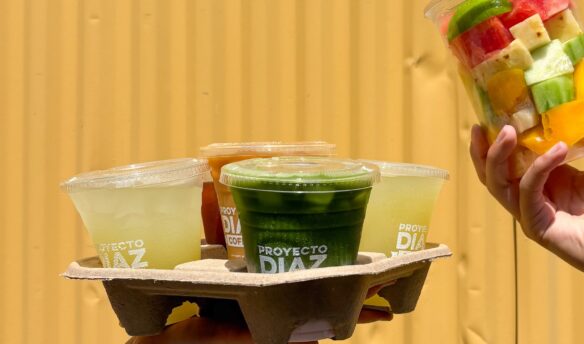This article is sponsored by our partner, Usonian Systems.
It’s all heating up in the coffee roasting industry. Inflation in the US hit 9.1% this June. Prices are rising, and hiring enough staff to run an efficient business is becoming harder than ever.
How are coffee roasters supposed to run effective operations and implement systems to scale up in the face of such challenges?
The answer? Hone in on operational efficiency. With the economy and job market in their current state, there’s never been a better time to focus on investing in efficient systems. After all, it’s the key to turning a mean profit today—and future-proofing your business for the challenges of tomorrow.
And according to Ryan Karatimus, President of the roasting equipment provider Usonian Systems, the best way to do that is with automation.
Take The Weight Off Your Staff With Automation
Karatimus told Fresh Cup that many of his clients are struggling through multiple challenges—from staff shortages and shifts in coffee buying preferences to growing concerns about employee safety and ergonomics. These hurdles have made running roasting operations that much more complicated. How’s a coffee roaster supposed to keep up, let alone thrive?
The answer lies in automation. Despite what you might think, automation is not your enemy. Automation doesn’t mean replacing your employees. It doesn’t mean your product is less “human” or “organic.” It’s simply a way to streamline your operations, remove strenuous and often tedious tasks associated with roasting, bagging, and shipping coffee, and making your business more appealing to new applicants.
Automation is also a way to grapple with the increased demand for DTC (direct to consumer) sales the industry has seen since the pandemic. According to statistics from the US Census, e-commerce sales increased by 43% in the first year of the pandemic—from $571.2 billion to a staggering $815.4 billion. And the uptick in volume means your employees are bagging more coffee than ever.
Automated systems also lessen the constant physical burden on your staff—if you’ve ever had to lug 70kg+ bags of green coffee around a warehouse all day, you’ll understand. Karatimus explained that investing in automation allows you to reinvest that money into higher wages to keep staff around for longer.
“I used to bag 2,000 bags of coffee per week,” Karatimus told us. “You get really good at it. At the same time, I would have rather put it in a weigh and fill machine, do it five times faster, then refocus on tasks that are much more valuable for the company.” Automation can free up staff to focus on tasks like shipping solutions, quality control, or marketing.
But Karatimus also cautions that automation is not for everyone. It is an investment that requires capital, and if you’re bootstrapping and don’t have a lot of excess cash flow right now, then it’s probably not the right time to think about automation systems. You’d be better off spending that money on marketing and increasing your sales volume.
Getting Started With Roasting Facility Automation
The world of automation can be intimidating—there are a lot of different machines and processes to think about. Luckily for us, Karatimus and Usonian Systems have years of experience helping companies get started with this process.
He told us that most roasting operations face two significant challenges: green bean storage and moving heavy coffee bags around the warehouse and roasting facility. Let’s take a closer look at both factors.
Suboptimal Green Coffee Storage
Most coffee roasters store their green beans in bins or stacked on pallets. But these take up a lot of space and are inefficient when accessing green coffee when you need it. Plus, scooping coffee out of a storage bin is time-consuming and can lead to wrist pain or injury.
“A far better option,” said Karatimus, “is using a coffee silo.” Coffee silos are high-capacity storage units that make discharging green beans quick and ergonomic—see the image above. Beans are swiftly pulled into the silo via a hose or vacuum and come out by tapping a button through the slide gate.
Silos can also be outfitted with a vacuum sleeve that cleans dust, twigs, and other debris from green coffee. It’s great for quality control (and those with allergies), but these systems can be noisy and expensive, coming in at around $200,000.
Even without a vacuum, silos are an excellent investment—you can use a valve or shoot to pour beans into a bucket as needed. They can even self-empty based on weight, further automating the process. And while they might be large, they’re a lot more space efficient than single pallets stacked randomly throughout your base of operations.
Quit Carting Heavy Coffee Around
“Coffee isn’t light,” says Karatimus, “Jute bags of green coffee can weigh up to 70kg (154lbs)—lugging those bags around your warehouse all day isn’t the best use of your team’s energy, especially when that’s something that can be so efficiently automated.”
Conveyor systems are the best way to reduce the physical burden on your staff by moving large amounts of coffee safely. The basic idea is to gently move the beans from your storage system to your roaster or from your roaster to the bagging area.
“There are many different coffee conveyance systems, but some basic ones are pneumatic or vacuum lifts,” says Karatimus. “You have a larger central vacuum with a lot of pipes [leading] to many different areas in your workspace. No more lugging heavy sacks around.”
Karatimus explains that one thing to be aware of is how loud vacuum lifts can be. “I’m a big fan of reducing your total decibel level in your roastery because, well, I like my ears. So always look at your decibel rating on your vacuum. You can find a quiet and cost-effective model easily enough.”
Automation Helps You Design A Robust Roasting Operation
These automations, enabled by cutting-edge gear and technology, are just the tip of the iceberg. There’s a whole realm of possibilities out there, from weigh and fill machines and band sealers to optical coffee sorters and bucket elevators.
That’s why Karatimus created the Automation Toolkit: it’s a complete breakdown of coffee roastery automation suggestions with implementation tips, prices, and more.
Investing in automation can make running a roasting business a lot easier—and a lot more profitable. But picking the right equipment for your roastery can be a challenge. If you’re curious about automation and need some tailor-made advice for your business situation, give Karatimus at Usonian Systems a shout.




















